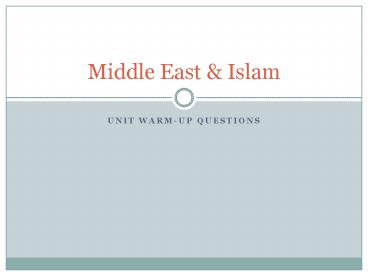Unit Warm-up questions - PowerPoint PPT Presentation
1 / 18
Title:
Unit Warm-up questions
Description:
Middle East & Islam UNIT WARM-UP QUESTIONS Ch 3.1 Which of the following was NOT part of the nomadic way of life of the early Arabians: a. – PowerPoint PPT presentation
Number of Views:66
Avg rating:3.0/5.0
Title: Unit Warm-up questions
1
Middle East Islam
- Unit Warm-up questions
2
Ch 3.1
- Which of the following was NOT part of the
nomadic way of life of the early Arabians - a. They wandered without any type of migration
- route.
- b. Their lives revolved around the seasons.
- c. They lived in close family groups (tribes).
- d. They were herders.
3
- The Ka'bah is
- A) the main trade route across Arabia.
- B) a desert oasis established for non-Arab
merchants. - C) the fortification that protected religious
pilgrims. - D) an important religious shrine in Mecca.
4
Ch 3.2
- The individual considered to be the father of
both the Arabs and the Jews is - A) Moses.
- B) Mohammed.
- C) Abraham.
- D) Gabriel.
5
- The verses of the Qur'an were first revealed to
- A) Gabriel.
- B) Muhammed.
- C) Ishmael.
- D) Abraham.
6
- The Qur'an is the
- A) description of all words and deeds of
Muhammed's life. - B) beliefs and practices of Islam.
- C) collection of all revelations to Muhammed by
Allah. - D) beliefs of Judaism and Christianity accepted
by Muslims.
7
- The Sunna is the
- A) collection of Gabriel's revelations to
Muhammed. - B) sacred house of worship for Muslims in Mecca.
- C) actual collection of words revealed by Allah
to Muhammed. - D) authentic source of Islamic beliefs and
practices.
8
CH 3.2
- To which city in the ancient world do Muslims
make their religious pilgrimage? - A) Jerusalem
- B) Constantinople (Istanbul)
- C) Mecca
- D) Baghdad
9
- The Islamic term that means to struggle to do
one's best to resist temptation and overcome evil
is - A) hijrah.
- B) mosque.
- C) hadith.
- D) jihad.
10
Ch 3.3
- 14) A statement of faith and giving charity are
two of the - A) rites of the Hajj.
- B) teachings of the caliphs.
- C) chapters of the Islamic holy book.
- D) Pillars of Islam.
11
- 9) The city that became the cultural center of
Muslim Spain was - A) Toledo.
- B) Granada.
- C) Cordoba.
- D) Seville.
12
- 10) Christians and Jews in the Muslim Empire
- A) had full religious freedom.
- B) could not hold positions in government.
- C) were expelled from the Empire.
- D) were forced into military service.
13
- (CST) In the 700s A.D., Arabian merchants played
a important role in - A) spreading new technology among Asia, Africa,
and Europe. - B) converting large numbers of Western Europeans
to Islam. - C) uniting most Asia and Europe under a single
religion. - D) stopping the invasions of nomadic people from
Central Asia.
14
- 15) Muslims who believed that the caliph should
be a direct descendant of Muhammad were called - A) Hajj.
- B) Shia.
- C) Israelite.
- D) Sunni.
15
- 12) Under the Umayyad dynasty, the Empire of
Islam expanded to - A) Europe and north Africa.
- B) North Africa and Indonesia.
- C) Central Asia and northern Europe.
- D) All of the above.
16
- 11) Why was the period under Abbasid rule
(800-1000 C.E.) known as the Golden Age? - A) because of the wealth earned through trade and
taxes. - B) because of the amount of territory conquered
under the Abbasids. - C) because of the large number of converts to
Islam. - D) because of accomplishments in art,
architecture, and literature.
17
- In what way did the practice of tolerance affect
the Jewish people of Cordoba? - A)They were able to contribute to the citys
cultural growth. - B)They were required to convert to Islam.
- C)They were required to practice their religion
in secret. - D) They were allowed to export textiles and
jewelry.
18
- 13) The Ottoman Empire reached its cultural peak
during the rule of - A) Abu Bakr.
- B) Mehmed II.
- C) Suleyman I.
- D) Esmail.































